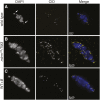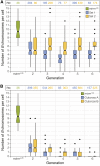Discovery of supernumerary B chromosomes in Drosophila melanogaster
- PMID: 24478336
- PMCID: PMC4286233
- DOI: 10.1534/genetics.113.160556
Discovery of supernumerary B chromosomes in Drosophila melanogaster
Abstract
B chromosomes are small, heterochromatic chromosomes that are transmitted in a non-Mendelian manner. We have identified a stock of Drosophila melanogaster that recently (within the last decade) acquired an average of 10 B chromosomes per fly. These B chromosomes are transmitted by both males and females and can be maintained for multiple generations in a wild-type genetic background despite the fact that they cause high levels of 4(th) chromosome meiotic nondisjunction in females. Most curiously, these B chromosomes are mitotically unstable, suggesting either the absence of critical chromosomal sites or the inability of the meiotic or mitotic systems to cope with many additional chromosomes. These B chromosomes also contain centromeres and are primarily composed of the heterochromatic AATAT satellite sequence. Although the AATAT sequence comprises the majority of the 4(th) chromosome heterochromatin, the B chromosomes lack most, if not all, 4(th) chromosome euchromatin. Presumably as a consequence of their heterochromatic content, these B chromosomes significantly modify position-effect variegation in two separate reporter systems, acting as enhancers of variegation in one case and suppressors in the other. The identification of B chromosomes in a genetically tractable organism like D. melanogaster will facilitate studies of chromosome evolution and the analysis of the mechanisms by which meiotic and mitotic processes cope with additional chromosomes.
Keywords: meiosis; minichromosomes; mitotic instability; supernumerary chromosomes.
Figures







References
-
- Beukeboom L. W., 1994. Bewildering Bs: an impression of the 1st B-chromosome conference. Heredity 73: 328–336.
MeSH terms
Substances
LinkOut - more resources
Full Text Sources
Other Literature Sources
Molecular Biology Databases

